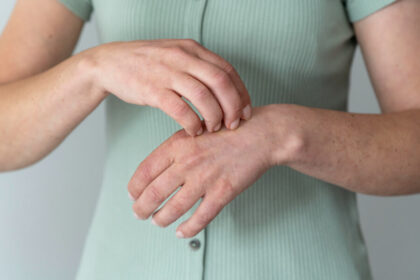Peripheral Artery Disease (PAD): What is it
Peripheral Artery Disease (PAD) is a common yet often overlooked condition that affects millions worldwide. It’s a circulatory problem characterized by narrowed arteries, reducing blood flow to the limbs.
It is a condition that causes narrowing of the arteries in your legs and arms. This narrowing is caused by a buildup of plaque, a fatty substance that accumulates on the inner walls of the arteries. This build up reduces blood flow to the legs and feet, which can cause pain, cramping, and other symptoms.
Peripheral Artery Disease (PAD) can lead to leg pain, cramping, and numbness, significantly impacting one’s quality of life.
Recognizing PAD Symptoms
The journey to understanding PAD begins with recognizing its symptoms. The most common symptom is leg pain that occurs while walking or exercising and typically disappears after a few minutes of rest.
This pain, known as claudication, results from the muscles not receiving enough blood during physical activity. Other symptoms include:
- Leg pain (claudication)
- Numbness or weakness in the legs
- Slow wound healing, particularly in the legs and feet
- Change in skin color (pale or bluish when elevated, reddish when lowered)
- In the legs and feet, hair loss or decreased growth is common.
- Shiny or tight skin on the legs and feet
- Poor nail growth, particularly on the toes
- Erectile dysfunction in men
- Chilly feeling in the foot or lower leg, especially in relation to the opposite leg
- Feet or leg pulses that be weak or nonexistent
- Pain or cramping in the hips, thighs, or calves after walking or climbing stairs
- Rest pain (pain in the feet or toes at rest, usually at night)
It is imperative that you see a physician if you encounter any of these symptoms.
PAD Causes
These factors can contribute to the development and progression of PAD. Managing these risk factors through lifestyle changes and medical treatment can help prevent or slow the progression of the disease.
- Atherosclerosis (buildup of fatty deposits in the arteries)
- Obesity
- Sedentary lifestyle
- Age (risk increases with age, especially over 50)
- Family history of PAD or cardiovascular disease
- Chronic kidney disease
- Autoimmune diseases (such as rheumatoid arthritis or lupus)
- Radiation exposure
- Injury to the limbs
- Blood vessel inflammation (vasculitis)
- Blood clotting disorders
PAD Risk Factors
Although PAD affects both men and women, African Americans are more likely to get it..
When compared to non-Hispanic White individuals, Hispanics may have comparable or somewhat greater incidence of PAD. 6.5 million adults 40 years of age and older have PAD in the United States have PAD.
Several risk factors can increase the likelihood of developing PAD, including:
- Smoking: The single most significant risk factor for PAD. Smoking damages the blood vessels, making them more prone to accumulate plaque.
- Diabetes: High blood sugar levels can lead to damage in the blood vessels, exacerbating the risk of PAD.
- High Blood Pressure: It can weaken arteries over time, leading to narrowed passageways.
- High Cholesterol: Excess cholesterol can build up on the artery walls, reducing blood flow.
Understanding these risk factors is the first step in prevention and management.
PAD Treatment Options
Treatment for Peripheral Artery Disease (PAD) focuses on managing symptoms and stopping the progression of the disease. Here are the primary treatment options:
- Lifestyle Changes: Incorporating a healthy diet, regular exercise, and quitting smoking can significantly improve PAD symptoms.
- Medication: Medicines can help manage pain, improve blood flow, and prevent blood clots.
- Angioplasty: A procedure to reopen narrowed arteries using a small balloon.
- Bypass Surgery: Creating a graft bypass using another vessel from the body or a synthetic tube.
Each treatment plan is tailored to the individual’s needs, so it’s essential to work closely with a healthcare provider.
Living with PAD
Living with Peripheral Artery Disease (PAD) requires a commitment to heart health and lifestyle adjustments. Regular check-ups, a balanced diet, and staying active are vital components of managing PAD. Support groups and educational resources can also provide valuable information and emotional support.
Conclusion
Peripheral Artery Disease (PAD) is a serious condition, but with the right knowledge and care, individuals can manage their symptoms and lead fulfilling lives. By understanding PAD symptoms, recognizing risk factors, and exploring treatment options, we can take proactive steps towards better heart health.
Remember that you have control over your heart health. Act now to ensure better health tomorrow.
FAQs
What is Peripheral Artery Disease (PAD)?
Peripheral Artery Disease (PAD) is a condition characterized by narrowed arteries, primarily affecting the legs, due to the buildup of fatty deposits (atherosclerosis).
This narrowing restricts blood flow to the limbs, leading to various symptoms such as leg pain, numbness, and slow wound healing.
What are the peripheral artery disease (PAD) risk factors?
Several factors increase the risk of developing Peripheral Artery Disease (PAD) , including smoking, diabetes, high blood pressure, high cholesterol, obesity, sedentary lifestyle, age over 50, and a family history of PAD or cardiovascular disease.
Other factors such as chronic kidney disease, autoimmune diseases, and radiation exposure also contribute to the risk.
What are the symptoms of PAD?
Symptoms of Peripheral Artery Disease (PAD) may include leg pain (claudication), numbness or weakness in the legs, slow wound healing, change in skin color, hair loss on the legs and feet, shiny or tight skin, poor nail growth, erectile dysfunction in men, and coldness in the lower leg or foot.
How is PAD diagnosed?
Peripheral Artery Disease (PAD) can be diagnosed through a combination of medical history assessment, physical examination, and non-invasive tests such as ankle-brachial index (ABI), Doppler ultrasound, and angiography.
These tests help determine the extent of arterial blockages and assess blood flow to the limbs.
What are the treatment options for PAD?
Treatment for PAD aims to relieve symptoms, improve quality of life, and reduce the risk of complications.
It typically involves lifestyle modifications such as smoking cessation, regular exercise, and healthy diet, along with medications to control blood pressure, cholesterol, and blood sugar levels. In some cases, procedures like angioplasty, stenting, or bypass surgery may be necessary to restore blood flow to the affected limbs.
Can PAD be prevented?
While certain risk factors for Peripheral Artery Disease (PAD) such as age and family history cannot be changed, adopting a healthy lifestyle can significantly reduce the risk of developing the disease.
This includes quitting smoking, maintaining a healthy weight, being physically active, managing diabetes, hypertension, and high cholesterol, and following a balanced diet low in saturated fats and high in fruits, vegetables, and whole grains. Regular medical check-ups and early detection and management of risk factors are also essential in preventing PAD.





